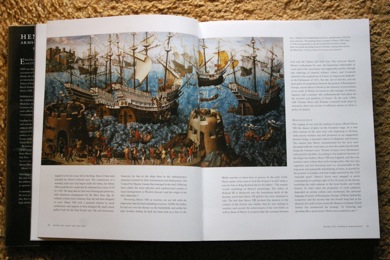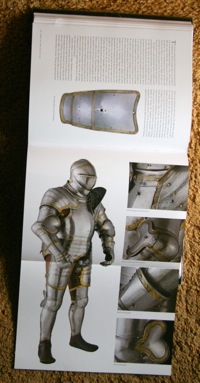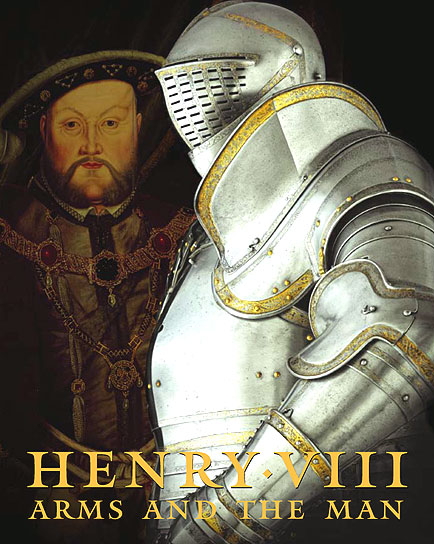
De Re Militari | Book Reviews
Graeme Rimer, Thom Richardson,
and J.P.D. Cooper (eds.)
Henry VIII: Arms and the Man
Leeds, UK: Royal Armouries, 2009. ISBN: 978-0948092626. £50. 368pp.
For those who were not paying attention, 2009 was the half-millennial anniversary of the ascension of Henry VIII to the throne of Great Britain. Exhibitions to his reign were mounted at the Tower of London, British Library, Windsor Castle, Hampton Court, the National Archives at Kew, the Mary Rose, and numerous regional sites, such as Wilton House in Wiltshire. One might even argue that The Tudors" on HBO was a sort of prequel to the anniversary. This volume, produced in conjunction with the Tower of London's (Royal Armouries) exhibition, Henry VIII: Dressed to Kill" is a lavish coffee-table book—though to call it that does it a disservice. It is far more than just a pretty thing to browse (though it is that—more anon), and as an entry into the catalogues of arms and armour, it is an impressive contribution.
First, I should emphasize that the book, Henry VIII: Arms and the Man, is not quite equivalent to the exhibition, Henry VIII: Dressed to Kill", though the catalogue of the latter is included in the former (and I must confess, I was not able to get to the Tower while it was on, to my sadness). Beyond a mere listing of the objects in the exhibition, the book includes nine essays by noted experts in their fields on all aspects of Henry VIII's reign. The volume opens with essays by J.P.D. Cooper and Lucy Wooding on Power and Personality" and Faith and Politics', respectively, that set the broad canvas of Henry VIII's reign. There are also quite interesting essays on medicine, the Tower, food and dining, dress and fashion, and the legacy of Henry, though they fall largely outside the scope for a DRM review and so I will pass over them here. These and all the introductory essays are a few thousand words in length and have a fair number of notes at the end of the book, though it should be said that the scope of all these essays is synthetic and in ways more historiographical than breaking a great deal of new ground. If, however, you have a generic knowledge of each of these areas, or better, are deficient in any of them for the reign, each essayist brings out the facets of the debate about Henry that have ebbed and flowed through academia in the last half century. These essays, modularly well-illustrated, comprise the first third of the book.
The military essays, perhaps oddly given the title of the book, seem at first glance to comprise only about 15% of the essay space—Steven Gunn on warfare and David Loades on the army and navy—but this is because the meat of the arms and armour essays are as introductions to the catalogue which is divided into subsections by topic. Gunn's and Loades' essays, though, give wonderfully concise overviews of Henry VIII's military and military actions, even if both unavoidably tread the same ground twice in different manners. Both go beyond the platitudes and are critical about the Henrician military achievement, Loades being more optimistic about the revolutionary changes (my words, not his) seen under Henry VIII. In their short essays, they can only delve very briefly into the more murky levels of interpretations of motivations and consequences.
Catalogue Sections
- Tournaments at the Court of King Henry VIII
- Henry VIII's Hunting Interests
- The Royal Armour Workshops at Greenwich
- The King and the Armourers of Flanders
- Henry VIII's Gun Shields
- Henry VIII's Firearms
- Arming the Early Tudor Army
- Artillery and Fortifications
- Catering (i.e., victualling) for the Henrician Army and Navy
- The Gentlemen Pensioners
There is much more if interest, though, in the series of separate interpretive essays on the various subject classes of the catalogue items. (see list at right) These essays seek to be both broadly conceived and yet focused on the objects on display at the same time. They provide a framework of both what could not be displayed in the exhibition as well as what was on display. These essays range from a single page or so (hunting) to a 8-10 page more in-depth analysis of a category (the Greenwich workshops, or artillery and fortification). Each essay demonstrates the interests of the curators who wrote them—all but one of whom are Royal Armouries people—and contain an interesting mixture of generalities and reference to primary (or historical secondary) sources. The entries for each individual item, written by a series of curators, are typically descriptive in nature with only the occasional citation to take the reader beyond the item itself. There are only 93 objects catalogued, but these and the interpretive essays occupy 225 pages in toto. In most cases the catalogue entry is a page long with a facing-page photo. A few items have merely a paragraph (Henry VIII's tennis ball, for example), while others get 2-3 pages of description and multiple photographs (full garnitures, for example).
The supreme accomplishment of this book, however, is that it is large (26x31x3cm), copiously illustrated throughout with photographs, and it even has centerfolds. Yes, centerfolds! There are a half dozen gatefold pages throughout the book that allow the oversized reproduction of detailed photos of a number of the more stunning pieces of armour and weapons. The love of the object is also on display in the numerous pages with stunning close-ups of parts of armour, as you can see below in just one example. No doubt the full-colour throughout the book is in part responsible for its cost, but if one sets it against any elaborately illustrated, large-format exhibition catalogue from a university press of the last decade, it stacks up very favourably in terms of production value and cost.
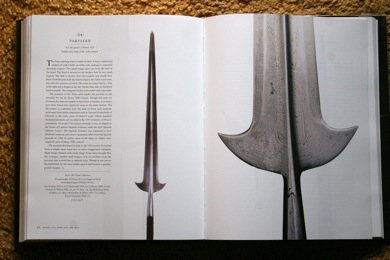
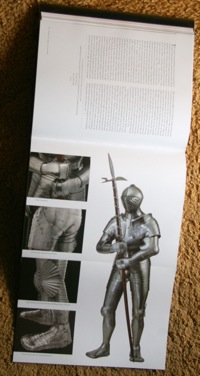
The one major problem with this book is distribution. Amazon.com will tell you "Out of Print--Limited Availability" which is not true, Amazon.co.uk does not even list it as existing under that title (though one can find it by ISBN, and similarly supposedly out of stock), and another UK retailer's entry for it says This item is not a usual stock item, and we currently cannot source it." As far as I can tell it is not available in the US at all; even the Met does not seem to stock it, and they are usually pretty good on armour exhibition catalogues. The problem is that none of the major retailers been willing to pre-buy hundred of copies for their warehouses, and no major book distributor has picked it up. So, its relative retail invisibility has encouraged me to break the usual taboo of a reviewer directing readers to a retail opportunity (I derive no gain from this): you can get it through UK resellers Waterstones and Blackwell's (each £5 over list), as well as directly from the Royal Armouries online shop (though for reasons that escape me the main website at the Tower of London made no mention of it during the exhibition, though it can be found on their online shop as well).
